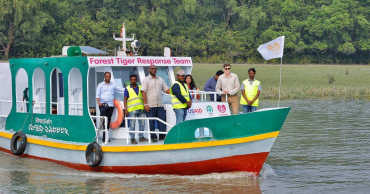World Wetlands Day
UN: Revive, restore wetlands, home to 40% of all biodiversity
Although coastal and freshwater wetlands – such as swamps, mangroves and marshes – contain 40 percent of all plant and animal species, many are polluted or degraded due to climate change and human development.
On World Wetlands Day Thursday, the UN called for urgent action to revive and restore these ecosystems, which are disappearing three times faster than forests.
Wetlands cover roughly six percent of the Earth's land surface and are vital for human health, food supply, tourism and jobs.
More than a billion people worldwide depend on them for their livelihoods, while their shallow waters and abundant plant life support everything from insects to ducks to moose.
Wetlands also play a crucial role in both achieving sustainable development and the fight against climate change.
They provide essential ecosystem services such as water regulation, and reducing the impact of flooding, for example.
Peatlands, a particular type of vegetated wetland, store twice as much carbon as forests.
However, over the past 200 years, wetlands have been drained to make way for farmland or infrastructure development, according to the UN Environment Programme (UNEP).
Roughly 35 percent of all wetlands globally disappeared between 1970 and 2015, and the rate of loss has been accelerating since the year 2000.
Depending on the amount of climate-related sea level rise, some 20 to 90 percent of current coastal wetlands could be gone by the end of the century, the UNEP said.
Wetlands have also suffered more biodiversity loss than other land and marine ecosystems.
Leticia Carvalho, head of the agency's Marine and Freshwater Branch, urged governments to end policies and subsidies that incentivise deforestation and wetlands degradation, and urgently focus on restoration.
Read more: Historic biodiversity agreement reached at U.N. conference
"At the same time, we must guide and drive investments to protect priority ecosystems, such as peatlands, and encourage the private sector to commit to deforestation and peatland-drainage-free supply chains," she added.
Recently, governments have been stepping up efforts to protect wetlands.
At the UN Biodiversity Conference in December, countries agreed a landmark deal to protect a third of the planet's lands, coastal areas and inland waters by 2030.
Action to restore wetlands is gathering momentum around the world. For example, China is developing the "sponge cities" concept, in the face of rapid urbanisation and intensified climate hazards, including flooding.
Initiatives include "green" rooves, constructed wetlands and pavements that capture, slow down and filter stormwater.
2 years ago
On World Wetlands Day, India adds two more Ramsar sites
On International Wetlands Day 2022, India added two Ramsar sites upscaling the number from 47 to 49.
The two new Ramsar sites (Wetlands of International Importance), Khijadia Bird Sanctuary in Gujarat and Bakhira Wildlife Sanctuary in Uttar Pradesh were announced on Wednesday, reports ANI.
The 47th Ramsar site was Uttar Pradesh's Haiderpur Wetland.
Union Environment Minister Bhupendra Yadav said, "Development and environment should walk together in a perennial manner. 40 per cent of biodiversity comes from the wetland."
Furthermore, while stressing the importance of wetland day, he said, "Today is International wetland day. There are more than two lakhs of small ponds in India but there are also a few that needs to be preserved. India has 52 national tiger forests in India. There are two blue tag beaches in India. We have added two Ramsar sites today."
While, Haryana Chief Minister Manohar Lal Khattar, said, "There are 18,000 ponds in Haryana, now at least 6,000 ponds are overflowing and are full of dirt. We have formed Pond authority to take care of it. This authority this year aims to preserve/ maintain 1,900 ponds."
Haryana has also introduced pensions for trees as well.
After this announcement, India now has a network of 49 Ramsar sites covering an area of 10,93,636 hectares, the highest in South Asia.
Read: How India plans to spiff up economic growth
Bakhira Wildlife Sanctuary in Uttar Pradesh provides a safe wintering and staging ground for a large number of species of the Central Asian Flyway. Khijadia Wildlife Sanctuary is a coastal wetland with rich avifaunal diversity providing a safe habitat to endangered and vulnerable species.
Ramsar Sites in India are declared under the Ramsar Convention, which was established by UNESCO in 1971. A site is declared as a Ramsar Wetland Site in India if it meets any one of the nine criteria set under the Convention of Wetland.
Environmentalists are of the view that following wetlands destruction, floods and drought damage, nutrient runoff and water pollution, shoreline erosion, has triggered a decline in wildlife populations.
Space Applications Centre (SAC), Ahmedabad today released National Wetland Decadal Change Atlas highlighting the changes which have happened in Wetlands across the country in the past decade.
Efforts to conserve wetlands in India began in 1987 and the main focus of governmental efforts was on biological methods of conservation.
3 years ago
US envoy visits Sundarbans to promote wildlife, conservation
US Ambassador to Bangladesh Earl Miller, accompanied by USAID Mission Director Derrick Brown, has visited the Sundarbans to support the growing partnership between the United States and Bangladesh.
5 years ago




